Introduction
This raid has some of the more lenient DPS checks in terms of on-content Ultimate fights. However, as the first two phases are quite downtime-heavy, the difficulty of the DPS checks in those phases will vary greatly depending on your composition, so you may find yourself having to shift your damage around these first two phases a fair bit. Additionally, this fight sees a much larger population of double caster compositions than prior Ultimate fights, due to the popularity of Pictomancer in the fight. This guide will account for as many scenarios as possible regarding damage compositions and fake melee positions.
The fight consists of five primary phases and an intermission phase, with varying DPS checks and mechanical difficulties. These phases are commonly referred to by numbers, and will be referenced as below:
- Fatebreaker: P1
- Usurper of Frost: P2
- Ice Veil/Crystals of Light: Intermission
- Oracle of Darkness: P3
- Oracle Duo: P4
- Pandora: P5
Gearing and GCD Speed
This fight doesn’t really benefit from any particular GCD speed value, as most phase timings leave you with plenty of time to get your last hit in on the boss regardless of your GCD. The one exception to this is P4, where your final GCD may be a bit tight on slower GCD speeds. However, this singular case isn’t really enough to recommend against using a slower GCD speed, and so we recommend you use whichever 7.05-7.15 BiS set is most comfortable for you speed-wise.
Addle and Magick Barrier Usage
Generally speaking, each phase has two different patterns of Addle mitigation that you can use. By picking one of these patterns in phase 1, you will be locked into that pattern for phase 2. Therefore, it is important to know what your group is doing so that you know where it will be most helpful for you to use Addle.
Magick Barrier should typically be used on downtime mechanics in the first two phases, and then it can be used as extra mitigation from P3 onwards, either to fill in gaps or provide additional reinforcement to particularly heavy hits.
Embolden and Potion Usage
In this fight, Embolden should be used off cooldown until P3. Once you reach P3, the next three uses of raid buffs will typically be delayed. In P3, raid buffs are delayed due to the stun at the end of Ultimate Relativity, and in P4, they are delayed because we want to maximize buffed cleave damage on both bosses. We then hold our raid buffs at the end of P4 to get three uses in P5, as P5 has the tightest DPS check of any phase in the fight.
- P1: Opener [potion] and post-Fall of Faith
- P2: Mirror, Mirror
- Intermission: Second GCD or ASAP, whichever comes later [potion]
- P3: Second GCD after Ultimate Relativity
- P4: Right as Oracle of Darkness becomes targetable [potion off cooldown]
- P5: Reopener, Fulgent Blade 2 cast, after final Akh Morn
Manafication Usage
Unlike the Ultimate fights in Endwalker, using Manafication off cooldown in this fight is highly impractical for two main reasons:
- A successful and strict Manafication rush in this fight requires your P1 and P4 killtimes to lose only a combined 7 seconds to their enrage times, with very little flexibility.
- While holding damage in P1 is common, it is extremely uncommon for groups to hold damage in P4, as doing so does not generally benefit other jobs (a typical P4 killtime is around 10 seconds before enrage).
However, starting in P4, we don’t want to fully align with buffs, as we have the potential to gain a usage relative to our uses of Embolden, due to the holding of buffs right before the P5 transition cutscene. By using Manafication no later than after our 10th GCD in the phase, we are able to press it again just before being stunned at the end of Crystallize Time and spend it as soon as the bosses become targetable again, which has it come off cooldown just in time for our reopener on Pandora.
Additionally, if your group has high P1 damage, we have the potential to “smuggle” our stacks of Enchanted Swordplay and our Prefulgence proc from the second use of Manafication into P2 by delaying it until after we finish a combo in the second burst window of the phase. This will be discussed in more detail in the P1 section of the guide.
Vercure Usage
As with other fights in the game, Vercure can be used during downtime in-between phases and during downtime mechanics; Utopian Sky and Diamond Dust are the primary use cases in this fight. Most downtime phases in this fight should be ended with a Dualcast prepared, so that you can open on the boss with an instant cast. Additionally, in any downtime mechanic where you aren’t using your sprint and raise recovery is an option, you can prepare a Dualcast to have it ready for any raises.
AoE for Mana Generation and Holding DPS
If your group wants a slower P1 killtime, you can contribute to this without losing out on mana generation by using Verthunder II and Veraero II to keep generating mana while dealing significantly reduced damage. Additionally, if your P1 killtime is faster than you expected it to be, you can take advantage of the fixed killtimes of P2 and P3 by using these spells to generate mana if your damage is more than enough to take the bosses below 20% before they hit their enrage timers.
Phase One: Fatebreaker
The suggested opener for this fight starts your first melee combo early in order to fit two uses of Grand Impact into buffs without using Swiftcast, as using Swiftcast makes us unable to get our last GCD before the boss becomes untargetable. The Addle usage in the opener assumes that your mitigation plan has you using Addle on the opening cleaves and stack/spread, and our last melee-range oGCD happens right before having to move away from the boss for spreads.

Utopian Sky
You can make liberal use of Vercure here to help your healers. Starting a Vercure cast at around the “n” in the Blasting Zone cast bar will snapshot the healing after you take damage, and you can cast a second Vercure immediately afterwards to give yourself some wiggle room for the upcoming mechanic. Similarly, you can start a Vercure cast at around the “a” in the Cyclonic Break cast bar, then immediately cast a second one for safety. Alternatively, during prog, you can hold your Dualcast until after the AoEs resolve to see if someone needs to be revived.
Once the tethers go out, you can prepare a Dualcast as soon as you reach your position before the knockback, and it will last long enough to use after downtime ends. In order to get all of your oGCDs out, it can be helpful to use Swiftcast right after the knockback ends to give yourself two weave windows while keeping a charge of Acceleration.
Example Utopian Sky: https://www.twitch.tv/cyclopsdragon/clip/AnnoyingCaringYamPicoMause-XjprG0A9RFf8K7Aw
Fall of Faith
Assuming you are doing a conga line setup for this mechanic, you may want to hold your sprint for it, so that if you get a tether assigned to the west side, you can get into position more quickly to avoid confusing people looking for positions in the conga line. You can use your charge of Acceleration to temporarily align your weaves for Fleche, then use the Grand Impact proc to facilitate whatever movement you need to do between the hits of the mechanic. Use Swiftcast as it comes off cooldown to re-align your Dualcast in time for Contre Sixte coming off cooldown.
Two-Minute Burst and Towers
The second hit of Burnt Strike happens around the second-last GCD of your burst, meaning we have multiple burst options that account for both lightning and fire here. If you plan to do a double melee combo for this burst, you can easily set up a -5 double combo, weaving Embolden and Manafication after the first Redoublement. If your party composition particularly struggles with damage in this phase, you can hold a use of Corps-a-Corps for when the towers resolve so that you can use a third melee combo after towers. Once the boss dies, prepare a Dualcast for the P2 opener.
Conversely, if your party has no issues with the DPS check and is considering holding damage into the next phase, you can “smuggle” your free combo and Prefulgence into P2. Don’t start a combo until after you’ve used Embolden, then execute the entire combo and finishers before using Manafication, then Dualcast once and use Acceleration to get Grand Impact in buffs. After buffs end, keep an eye on your Enchanted Swordplay timer as the boss dies. If the boss dies before the timer hits 10s, prepare a Dualcast going into P2. If the timer hits 10s before the boss dies, you will need to open with a combo to avoid having the buff fall off. Without a prepared Dualcast, the sequence looks something like this:

With a late killtime, you can further optimize this sequence by spending a use of Enchanted Reprise and both instants from a use of Acceleration before initiating the combo, then using Manafication after Enchanted Redoublement. Since you might aim to enter P5 with 100|100 mana, which necessitates a bit of overcap in most scenarios, a single use of Reprise won’t adversely affect your mana in a scenario where your P1 killtime is close to enrage.
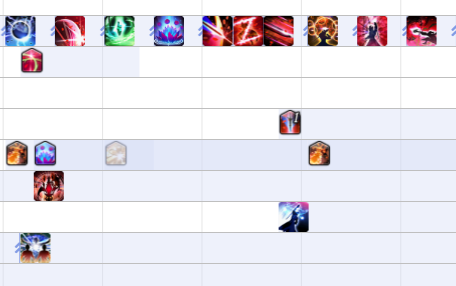
Mitigation Usage
If your mitigation plan doesn’t have you use Addle in the opener, it might ask you to use it for the first Burnished Glory raidwide, after Utopian Sky. However, it can be rough for us to have the bandwidth to get all of our weaves out. If you use Magick Barrier about a second after the tethered players have been suspended in the air, it will cover both the stacks and the following Burnished Glory raidwide. Realistically, this is enough to cover your assigned mitigation for this raidwide, and you should be using this Magick Barrier regardless of your mitigation plan.
If you used Addle in the opener, you should Addle the second Burnished Glory raidwide, and you should try to do it during the castbar so that it also covers the tankbuster. It might not be necessary depending on when your tanks are using their invulns, but it’s good practice to do it anyway.
Phase Two: Usurper of Frost
You have the equivalent of 14 GCDs’ worth of uptime on the boss before Diamond Dust. Our default option for this reopener is with a prepared Dualcast, unless you are doing the Swordplay smuggling strategy and don’t have enough time to spend the charges after an instant spell.
If you open with an instant cast from a prepared Dualcast, you will have an odd number of GCDs left before downtime (i.e. 1 GCD casted, 13 remaining), so you will have to use a melee combo or Swiftcast, but not both, or you will lose an instant cast.
Default: 1 combo, 0 Swiftcast, 9 casts (including prepared Dualcast)
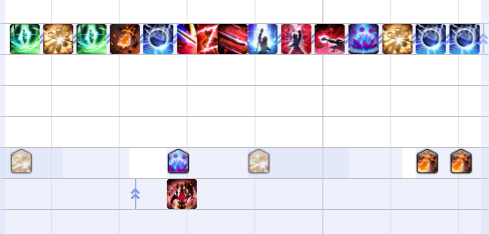
Swordplay smuggling without prepared Dualcast: 1/2 combos, 0/1 Swiftcast, 4/9 casts
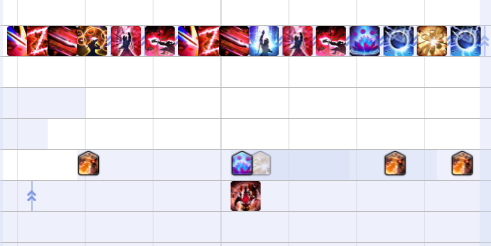
Swordplay smuggling with prepared Dualcast: 1/2 combos, 0/1 Swiftcast, 4/9 casts
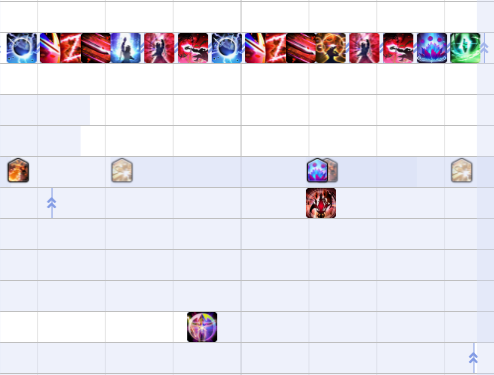
Casts only (needed to use three combos at the end of P1): 0 combos, 1 Swiftcast, 14 casts (including Grand Impact carried over from previous phase in place of a prepared Dualcast)
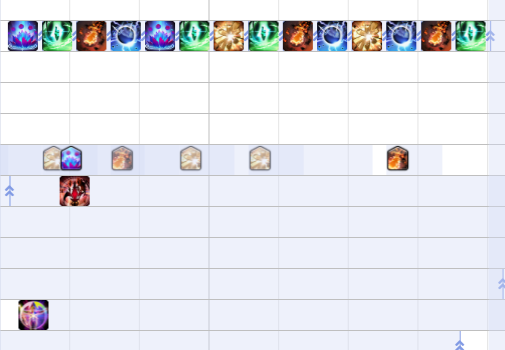
You should aim to spend all uses of Acceleration, Corps-a-Corps, and Engagement before the downtime starts. If your P1 kill was fast, you might not be able to get your last uses out before the boss is untargetable; in this scenario, they will overcap during downtime. This is why we suggested reopening with a double instant after Utopian Sky, to maximize your chance of getting these uses. It’s also advisable to not use Grand Impact as your last GCD before downtime, as the delayed damage application can cause it to ghost. Use it before the last GCD.
Diamond Dust
You can use Vercure to prepare a Dualcast after the knockback, as soon as the ice star AoEs explode. This Dualcast can either be used after the second or third hit of the stacks to assist your healers, since you are the squishiest caster DPS, or it can be held until after the stacks resolve to pick up a dead party member. You can then prepare another Dualcast after you are finished sliding, then use Swiftcast to open with two instant casts.
Mirror, Mirror
When the boss becomes targetable again, you should weave Fleche and Contre Sixte after your first instant cast. The second weave window is open for Addle if your mitigation plan calls for it.
This mechanic poses a logistical challenge for us on Red Mage in the ranged position, as it happens during a burst window and forces us away from the boss. The ideal melee combo timing for this mechanic is to start a melee combo on the fourth or fifth GCD after the boss becomes targetable. With a late P1 killtime, you can easily get an ideal Embolden timing for your double melee combo, as shown in the clip below. Just ensure that you have a spare use of Displacement to jump towards the first mirror after your second Redoublement. As a general rule of thumb, if your Engagement cooldown timer is lower than your Fleche cooldown timer, you should spend the charge, as Fleche comes off cooldown right around when you need to be moving away from the boss. Otherwise, you can hold the charge without worrying about overcapping.
Example Mirror, Mirror sequence after a late P1 kill: https://www.twitch.tv/cyclopsdragon/clip/ExpensiveUninterestedCheesecakePeoplesChamp-F_dCM48RfmQ57LDx
If your P1 killtime is fast enough that you won’t align with buffs if you start your first combo on the fifth GCD, it’s better to take suboptimal buff alignment by starting the combo on the fifth GCD anyway, using Embolden when it comes off cooldown.
This is one of two instances in the fight where Red Mage has a significant difference when played in the melee position. Because of the fact that melees stay in range of the boss for the entirety of Mirror, Mirror, you don’t need to worry about faster P1 killtimes and can align your double combo with buffs in any scenario. However, you may want to ask for a tank mit, since you are somewhat squishy and will be out of range of the healers when the cleaves are hitting.
After your combos are finished, the rest of the movement can be handled with Dualcasts and whatever charges of Acceleration you have remaining. Sprint is helpful, but not necessary.
Light Rampant
During prog, it can be helpful to use Vercure to heal someone who’s being targeted by the puddles, as they take more damage than everyone else in the mechanic, so keeping them topped can help the healers out. However, it’s not helpful to use Vercure in this mechanic beyond early prog, as there aren’t any possible deaths that you can recover from with a well-timed Verraise.
Once you arrive at either the middle tower or your clock spot, prepare a Dualcast, then spend your charges of Corps-a-Corps and Engagement after spending the Dualcast. Use a melee combo, weaving Fleche and Contre Sixte as well as your remaining charges of Corps-a-Corps and Engagement when they come off cooldown, as there’s not enough time to get two uses of either Fleche or Contre Sixte in this short uptime phase.
If you are in the melee position, you may instead choose to spend Swiftcast during this phase, perform three Dualcasts, and end the phase with the start of a melee combo, so that you can carry finishers into Intermission. This may result in some mana overcap depending on your P1 killtime, but this shouldn’t matter if you plan to overcap going into P5.
Mitigation Usage
If your mitigation plan asks you to Addle the first Burnished Glory in P1, it will likely have you using Addle on Diamond Dust and the Banish into Light Rampant combo. If your mitigation plan asks you to Addle the P1 opener and the second Burnished Glory, it will likely have you using Addle on the Hallowed Ray line stack and the Absolute Zero enrage. Regardless of your plan, you should use Magick Barrier when the Usurper of Frost’s knockback animation happens during Diamond Dust, and on the Absolute Zero enrage.
Intermission
When you come out of being frozen, use Swiftcast instead of preparing a Dualcast, because you want to use a potion as soon as possible. Once your crystal is targetable, spend the Swiftcast on Veraero or Verthunder, then weave either Embolden or Fleche, depending on your party’s buff timing, as well as Manafication. Initiate a melee combo, weave whichever of Embolden or Fleche you didn’t already use, then weave Contre Sixte after Zwerchhau, and Corps-a-Corps and Engagement after Redoublement. If your P1 killtime was fast, then Embolden will not be off cooldown in time to use it early in the reopener; in this case, you should simply use it off cooldown.
If you are in the ranged position, you can move to your Dark Crystal after Redoublement. Depending on your level of confidence, you can press Sprint after your first finisher, run to the other nearby Light Crystal after your first baited cone appears, standing on top of it when you cast Resolution to cleave both, then run back to your Dark Crystal for the second bait. Regardless of what you do, you should weave Acceleration after the first finisher, as well as weaving Vice of Thorns and Prefulgence at any point while buffs are still active. Spend both the Acceleration and Grand Impact, then weave Acceleration again if it’s available, or Dualcast if it’s not.
Example ranged position sequence with Resolution cleave: https://www.twitch.tv/cyclopsdragon/clip/SpotlessMagnificentHamsterKappaWealth-C3j5AthnoI29RCJB
If all of the Light Crystals are destroyed at this point, you can initiate a melee combo on the Ice Veil, making sure to stay at max melee or step away after the Riposte to properly bait your Dark Crystal. If there are still living Light Crystals, you can use Acceleration if it’s come off cooldown, or a Dualcast if you already used your second Acceleration. Once your second melee combo is complete, if you did four casts between melee combos, you will have time for two more casts, and you should spend your second Acceleration if it hadn’t come off cooldown after using your first one. You should also be able to sneak in a second use of Contre Sixte at the end of the phase if you followed the given order of oGCDs.
If you are in the melee position, you may choose to start your second melee combo on your Light Crystal as well. This results in a bit more damage on your crystal, which can help because as a fake melee, you have a healer helping with your crystal instead of a tank. You can stand on the tip of a diamond pattern on the ground to align the Resolution cleave instead of having to target a distant crystal, as shown below. Further, if you carried the finishers over from before Intermission, you can use those instead of performing a second full combo, instead opting to start another combo at the end of the Intermission to again carry finishers into the next phase.
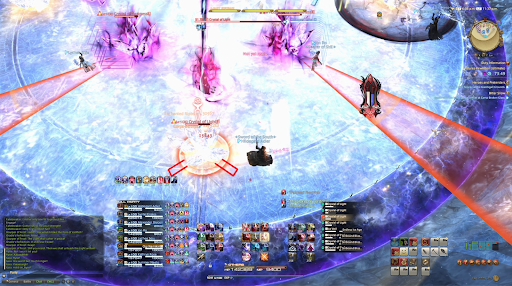
Phase Three: Oracle of Darkness
Prepare a Dualcast after the Junction raidwide in downtime, unless you are carrying finishers into the phase, in which case you may need to pop an Acceleration early to prevent overcapping due to how Intermission was handled. Unlike other phases, it is advisable to start this phase without using Swiftcast, resulting in an odd number of instant casts at the start, as this aligns your Dualcast movement windows very nicely with the movements in Ultimate Relativity. As usual, you should aim to get all of your oGCDs on cooldown as soon as possible entering this phase. If you followed this guide’s recommendations for Intermission, Contre Sixte will likely not quite be off cooldown in time for the first weave window, and so should be weaved in the second.
Ultimate Relativity
Despite the fact that you can technically handle all of the movement in Ultimate Relativity with Dualcasts, you will still need to use a melee combo and a charge of Acceleration to keep them from overcapping, and so it’s advisable to use them to assist with movement, especially when you need to move out for a fire drop while avoiding a laser baited towards where you need to drop your fire.
The easiest solution is to start a melee combo after Dualcast where the Ultimate Relativity cast finishes, then check your fire/ice debuff. If you have anything except the 20s fire debuff, you can weave Swiftcast after Redoublement, using it to move in after either dropping your rewind or baiting your laser. If you have the 20s fire debuff, you should instead finish the melee combo, Dualcast, then weave Swiftcast as you start moving out to drop your fire, using it to start moving back in after dropping your fire. Alternatively, you have enough time to check your debuff before your combo, and you can simply delay the combo by one Dualcast.
Initial combo timing with a non-20s fire debuff: https://www.twitch.tv/cyclopsdragon/clip/PlausibleAmorphousLobsterNotLikeThis-q4yTeOiXB8aUMnGN
Initial combo timing with a 20s fire debuff: https://www.twitch.tv/cyclopsdragon/clip/CrispyPopularPrariedogPeanutButterJellyTime-egbrCP2b4ysfJeJT
Using Acceleration to handle your second movement is recommended, especially if your second movement is a laser bait. In the ideal scenario, you’ll want to use another Acceleration to land a GCD before Return; however, with faster P1 killtimes, this isn’t always possible if you used a charge for movement. What you can do instead is position yourself on the side of the boss opposite to where you need to look for Return, so that casting a spell will automatically face you in the correct direction. If you’ve maintained full uptime throughout the phase, you should be able to complete the first half of a Dualcast before you are stunned for Return. However, this is not possible if you are baiting the last laser, and so if you want to prepare a Dualcast going into Return, you can use Vercure while facing in the correct direction.
See the below videos for some examples of handling movement in Ultimate Relativity:
Initial combo timing with a non-20s fire debuff: https://www.twitch.tv/cyclopsdragon/clip/PlausibleAmorphousLobsterNotLikeThis-q4yTeOiXB8aUMnGN
Initial combo timing with a 20s fire debuff: https://www.twitch.tv/cyclopsdragon/clip/CrispyPopularPrariedogPeanutButterJellyTime-egbrCP2b4ysfJeJT
Playlist of movement examples for each debuff: https://www.youtube.com/watch?v=GQrdIpqa6DE&list=PL1yy80rwHCKkAHgxdFYp-bOYcBXORWJGs
Buff Window into Apocalypse
As mentioned in the introduction, buffs should be held until after Return completes, and typically groups will buff around the second GCD. If you’ve carried over an instant cast from before Return, you should start comboing immediately after spending it; otherwise, start comboing immediately. Once your double combo is complete, there are a couple of different plans you can follow here, either comboing before Spirit Taker or during Dark Eruption spreads. In the general sense, do some Dualcast filler, spending Corps-a-Corps and Engagement after your second Dualcast if they are available, or holding them if they become available after the second Dualcast.
If you want to combo early, once you see the Apocalypse castbar, complete your current Dualcast pair, then initiate a combo, using the movement to find your safe spot. Ideally, you want your last instant cast to line up with the start of the Dark Eruption cast, so that you can do a hardcast while waiting for it to resolve, then use the Dualcast proc plus additional instant cast(s) to move to the middle. If you use the above combo timings for Apocalypse, the cast will start right after Resolution if your first GCD after Return was a combo, or right after the following Swiftcast if you use Swiftcast right after Resolution. Whichever timing you’re using, Sprint when you see the castbar, perform a Dualcast starting halfway through it, then use whatever instants you have remaining to run middle for the second set of stacks. If you can get away with holding a charge of Acceleration for the Darkest Dance knockback, it’s advisable to do so. If this isn’t possible, it’s fine to clip your GCD to weave Corps-a-Corps after the knockback. Doing this will not lose you a GCD in the phase, and if you start a Dualcast instead of gap closing back in, you risk missing the final water stack.
Example of an early combo sequence: https://www.twitch.tv/cyclopsdragon/clip/HotLaconicLocustThisIsSparta-rVkReJExr8msustQ
If you want to combo late, you will need to align your Dualcast with the Spirit Taker movement, which means you will need an additional Swiftcast if you opened post-Return with an instant, and then you can spend a charge of Acceleration for two additional instants. If you are in the ranged spot, it is advisable to only spend the Acceleration buff before initiating a melee combo, to ensure that you have ample time to disengage, saving the Grand Impact for after spreads. This will cover your movement until you move towards the middle, and then you can spend Swiftcast to handle the knockback.
Example of a late combo sequence: https://youtube.com/clip/UgkxORlwlWnRwJxM5rmc0utIMLBsa7tBFnUg?si=mMoDUQjbOm-wlsJD
Mitigation Usage
Intermission serves as a hard reset for mitigation, so you will once again be faced with two possible mitigation options from here. However, these are typically differentiated by whether your group is running a double caster composition.
As a solo caster, you will typically want to use Addle on Ultimate Relativity, then use Barrier on either the first UR fire spread or after your instant cast after Return to catch both Shell Crusher and the following Shockwave Pulsar. This will allow you to use Addle again on the Memory’s End enrage. You can also use Barrier on Memory’s End if you did the earlier timing (first UR fire spread).
If you are in a double caster composition, you may instead be asked to Addle two of the UR fire spreads or the Shell Crusher and following Shockwave Pulsar, and you can use Magick Barrier on whichever one you didn’t Addle.
Phase Four: Oracle Duo
If your killtimes will not allow you to end this phase with at least 80|80 mana while avoiding overcapping, we recommend intentionally overcapping mana at some point in this phase in order to enter P5 with 100|100. The two most likely candidates for overcapping are the reopener and post-Crystallize Time, and you may end up overcapping in both spots depending on your P1 killtime and whether you attempt to do any Reprise optimization in the first half of the fight.
Buffs will most likely be held for when the Oracle of Darkness becomes targetable; this happens roughly 10 GCDs into the phase. Probably the best way to approach this reopener is to prepare a Dualcast and Swiftcast in the short downtime before the phase starts, spend both, then stand in the middle and perform three more Dualcast pairs before starting your first melee combo. This timing has you move out for Akh Rhai right after the third Dualcast, and it allows you to weave Embolden and Manafication after Redoublement to line Embolden up with when the Oracle of Darkness becomes targetable. You don’t want to use Manafication any later than the 10th GCD’s weave window for reasons that will be discussed later.
However, if buffs are instead done off cooldown, do not adjust your combo timing at all. Maximizing your cleave damage is more important than having an “ideal” buff window.
Darklit Dragonsong
If you do this combo timing, you can target the Oracle of Darkness for the first finisher of your first combo, and your potion will come off cooldown after the first Resolution, assuming you used it ASAP in Intermission. Continue with a full triple combo, keeping in mind that if you end up in the north tower, you will need to switch targets back to the Usurper of Frost to do your third melee combo and spend any remaining charges of Corps-a-Corps and Engagement once you’re in the tower. Make sure you weave Acceleration during your third combo to avoid overcapping. The Oracle of Darkness will jump towards the farthest player after your third combo finishes, and this can cause her to be out of range to cleave both bosses. For the safest damage, you should do a Dualcast, use your lingering instant on Verthunder/Veraero, and then cast Grand Impact, at which point the bosses will have jumped middle and will be able to be cleaved again.
As per usual, make sure you spend all of your charges of oGCDs before Crystallize Time. The Oracle of Darkness becomes untargetable one second later than the Usurper of Frost, so if you weave Swiftcast after the Crystallize Time cast finishes, you can potentially sneak one last hit onto her before she becomes untargetable.
Crystallize Time
There are really no places where Vercure healing is helpful for this mechanic, and there are places where you want to sprint, which will cancel a prepared Dualcast. If you are popping the dragon heads, you can prepare a Dualcast once you’ve reached north or south after popping your dragon head. If you are picking up a puddle, you can prepare a Dualcast once you’ve arrived in your initial position, keeping in mind that it will get cancelled if you sprint to pick up your puddle.
Due to the fact that buffs are held at the end of this phase to get three uses in P5, we can gain a use of Manafication by using it right before the Return at the end of Crystallize Time, which is the reason we previously suggested using the first Manafication of the phase at the 10th GCD at the latest. You can then use the combo immediately when the bosses are targetable, spending your oGCDs in any order as long as you use Acceleration in time for Grand Impact and Impact to be your first two GCDs after Resolution, as they will be the last two GCDs you get if the bosses die as early as possible. Regardless of whether the bosses need more damage after these two GCDs, it’s advisable to only use one charge of Acceleration and allow it to overcap during the cutscene to allow for more consistent movement options in P5.
Mitigation Usage
You will typically be tasked with using Addle on either both Akh Morn + Morn Afah combos or on Crystallize Time. Make sure you use Addle on the Usurper of Frost for the Akh Morn Afah combos, or on Oracle of Darkness for Crystallize Time.
If you used Magick Barrier on Memory’s End, you won’t be able to use it again until the second Akh Morn Afah combo. If you didn’t use it on Memory’s End, you can also use it on Darklit Dragonsong.
Phase Five: Pandora
If you enter this phase with capped mana, you can consider the following movement plan.
- Acceleration and three melee combos for reopener buffs and Fulgent Blade 1 (exalines)
- Acceleration for Wings Light and Dark 1 (towers)
- One melee combo, Swiftcast, and Acceleration for Polarizing Strikes 1
- Swiftcast and three melee combos for 2m buffs and Fulgent Blade 2, with potion
- Acceleration for Wings Light and Dark 2
- One melee combo, Swiftcast, and Acceleration for Polarizing Strikes 2
- Acceleration and Swiftcast for Fulgent Blade 3, saving two melee combos for the final burst window
If you don’t enter this phase with capped mana, as long as you’re entering with at least around 85|85, you can shift some of the combos and your potion usage around to arrive on this plan.
- Acceleration and two melee combos for reopener buffs and Fulgent Blade 1
- One melee combo for Wings Light and Dark 1
- One melee combo, Swiftcast, and Acceleration for Polarizing Strikes 1
- Two melee combos for 2m buffs and Fulgent Blade 2, plus an Acceleration
- Dualcast for Wings Light and Dark 2
- One melee combo, Swiftcast, and Acceleration for Polarizing Strikes 2
- Three melee combos for Fulgent Blade 3, 2m buffs, and potion
It’s also possible to start with the 100|100 plan and then switch to the non-100|100 plan at any point up until Fulgent Blade 2, depending on your level of comfort with the non-combo movement at the end of Fulgent Blade 2 and during Fulgent Blade 3.
Once you regain control after the cutscene, immediately use Acceleration and cast either Verthunder or Veraero, weaving Fleche and Contre Sixte, then start a double melee combo weaving Embolden after the first Riposte or Zwerchhau depending on your party’s buff timing. The uses of your other damaging oGCDs are flexible here, as the enrage timer of this phase leaves barely not enough time for an additional use of any of them right at the end of the fight, but using Fleche and Contre Sixte earlier allows you more freedom for small drifts throughout the phase.
These two melee combos will cover most of the first set of Fulgent Blade exalines. After completing your second melee combo, cast Grand Impact to avoid losing it, and from this point on, you should follow the plan you’ve chosen. Here are some nuances and tips for each movement plan:
Capped mana plan:
- For both instances of Polarizing Strikes, ensure that you use Swiftcast early enough that you can use it again to align your triple combo at the next burst window. When you see the Polarizing Strikes cast bar, if you initiate a Dualcast, then weave and use Swiftcast immediately after that Dualcast, it will come off cooldown just as you want to weave it again.
- For Fulgent Blade 2, use Swiftcast to initiate a 123e triple combo. Weave your potion during your first combo, either after Enchanted Riposte or Verholy/Verfire.
- For Wings Light and Dark 2, it’s okay to let Acceleration overcap in order to let it fully cover movement.
- For Fulgent Blade 3, as soon as the first hit of the first set of lines goes off, weave Acceleration in your next weave window, then spend the Acceleration buff to move into the second hit. Use the newly-generated Verstone/Verfire proc to set up a Dualcast, moving into the second hit of the second set of lines after that Dualcast, then cast Grand Impact and weave Swiftcast to finish dodging the third set of lines. https://www.twitch.tv/cyclopsdragon/clip/MistyIntelligentFlyCclamChamp-8bMsQILC1Kam337T
Non-capped mana plan:
- Immediately after the Grand Impact in the reopener, use Dualcast and a Swiftcast to complete the movement for Fulgent Blade 1, and watch your Verstone/Verfire procs to ensure you don’t have one expire during a cast.
- For Wings Light and Dark 1, make sure you combo before overcapping mana, and take care to spend an Acceleration charge as well; this can be helpful for the movement if you need to combo earlier than expected.
- For both instances of Polarizing Strikes, you can start a Dualcast in the second half of the cast, then use Swiftcast, one combo, and both Acceleration instants to fully cover the movement.
- For Fulgent Blade 2, you can use a 1e23 or 123e double combo (depending on your reopener buff timing) to cover most of the movement, and finish the rest of it with a use of Acceleration.
- For Wings Light and Dark 2, you can handle this movement entirely with Dualcast if you’ve kept your uptime throughout the phase.
- For Fulgent Blade 3, ensure that you spend any remaining Acceleration charges, then aim for a -16s triple combo with a standard triple combo potion timing. An earlier reopener buff timing will have your first combo align without any adjustment, while a later reopener buff timing may require you to use Enchanted Reprise to delay your first combo while handling the first movement.
Good luck, and congratulations in advance on your clear!
Mitigation Usage
As a solo caster, you will typically be tasked with Addling all three Akh Morns, and as a fake melee caster, you will typically either be tasked with Addling the Fulgent Blade casts or the Polarizing Strikes. In either position, you should use Barrier on the first Akh Morn and the second Polarizing Strikes.
Clear PoVs
Draid Kylian (ranged position): https://www.twitch.tv/videos/2341164225
Accompanying log: https://www.fflogs.com/reports/PpgV8BFMNHChbntL?fight=5
Hildegard Adler (melee position): https://www.youtube.com/watch?v=2nhJm9DMzB4
Accompanying log: https://www.fflogs.com/reports/rzbNpVa2kG7KMQ8W?fight=5





